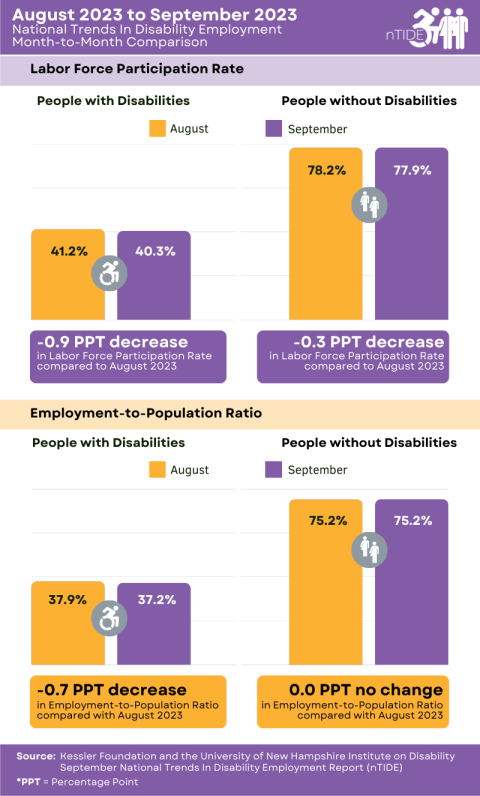
Join us for the next nTIDE Lunch & Learn Webinar featuring guest presenters Leslie Jones, Executive Director, and Dalia Sakas, Director of Music Studies at the Filomen M. D’Agostino Greenberg Music School (FMDG).
nTIDE September 2023 Jobs Report: Employment Trend Holds Steady at Historic Highs through Early Autumn for People with Disabilities
National Trends in Disability Employment (nTIDE) – Issued semi-monthly by Kessler Foundation and the University of New Hampshire
October 6, 2023 –The labor force participation and employment-to-population ratio have held relatively steady throughout the summer and into the fall for people with disabilities, while percentages for people without disabilities may have maxed out at their pre-pandemic baseline, according to today’s National Trends in Disability Employment – semi-monthly update (nTIDE), issued by Kessler Foundation and the University of New Hampshire’s Institute on Disability (UNH-IOD). In comparison, the employment-to-population ratio for people without disabilities remained flat with no change, while their labor force participation decreased slightly.
“The stability of percentages for both people with and without disabilities over the past four months might signal the desired soft landing from the recession hoped for by the Federal Reserve," explained John O’Neill, PhD, director of the Center for Employment and Disability Research at Kessler Foundation.
Month-to-Month nTIDE Numbers (comparing August 2023 to September 2023)

This graphic compares the labor market indicators for August 2023 and September 2023, showing a slight decrease in the labor force participation rate and employment-to-population ratio for people with disabilities. Both indicators remained the same from month to month for people without disabilities.
Based on data from the U.S. Bureau of Labor Statistics (BLS) Jobs Report released today, the employment-to-population ratio for people with disabilities (ages 16-64) decreased from 37.9 percent in August 2023 to 37.2 percent in September 2023 (down 1.8 percent or 0.7 percentage points). For people without disabilities (ages 16-64), the employment-to-population ratio remained the same at 75.2 percent. The employment-to-population ratio, a key indicator, reflects the percentage of people who are working relative to the total population (the number of people working divided by the number of people in the total population multiplied by 100).
Why has the labor force participation of people without disabilities remained the same? “In a sense, they may have returned to their pre-pandemic level and ‘topped out’ at this point,” added Dr. O’Neill.
The labor force participation rate for people with disabilities (ages 16-64) decreased from 41.2 percent in August 2023 to 40.3 percent in September 2023 (down 2.2 percent or 0.9 percentage points). For people without disabilities (ages 16-64), the labor force participation rate decreased from 78.2 percent in August 2023 to 77.9 percent in September 2023 (down 0.4 percent or 0.3 percentage points). The labor force participation rate reflects the percentage of people who are in the labor force (working, on temporary layoff (on furlough), or actively looking for work in the last four weeks) relative to the total population (the number of people in the labor force divided by the number of people in the total population multiplied by 100).
“The labor force participation of people with disabilities has remained relatively stable at all-time highs over the summer and into September,” said Andrew Houtenville, PhD, professor of economics and research director of the UNH-IOD.
Year-to-Year nTIDE Numbers (comparing September 2022 to September 2023)

This graphic compares the labor market indicators for September 2022 and September 2023, showing increases across the board for people with and without disabilities.
Compared to this time last year, the employment-to-population ratio for people with disabilities (ages 16-64) increased from 34.9 percent in September 2022 to 37.2 percent in September 2023 (up 6.6 percent or 2.3 percentage points). For people without disabilities (ages 16-64), the employment-to-population ratio also increased from 74.6 percent in September 2022 to 75.2 percent in September 2023 (up 0.8 percent or 0.6 percentage points).
Similarly, the labor force participation rate for people with disabilities (ages 16-64) increased from 38 percent in September 2022 to 40.3 percent in September 2023 (up 6.1 percent or 2.3 percentage points). For people without disabilities (ages 16-64), the labor force participation rate also increased from 77.1 percent in September 2022 to 77.9 percent in September 2023 (up 1 percent or 0.8 percentage points).
In September, among workers ages 16-64, the 6,323,000 workers with disabilities represented 4.2 percent of the total 150,541,000 workers in the U.S. workforce.
Ask Questions about Disability and Employment
Each nTIDE release is followed by an nTIDE Lunch & Learn online webinar. This live broadcast, hosted via Zoom Webinar, offers attendees Q&A on the latest nTIDE findings, provides news, updates from the field, and features invited panelists who discuss current disability-related findings and events.
On October 6, 2023, at 12:00 pm – 1:00 pm Eastern, guest presenters Leslie Jones, Executive Director and Dalia Sakas, Director of Music Studies at The Filomen M. D’Agostino Greenberg Music School joins Drs. O’Neill and Houtenville. Join our free Lunch & Learn live or visit the nTIDE archives at: ResearchonDisability.org/nTIDE. Also, register now for our mid-month Deeper Dive into employment trends at nTIDE Deeper Dive – 10/20/2023.
